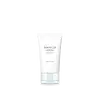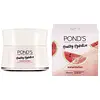What's inside
What's inside
 Key Ingredients
Key Ingredients

 Benefits
Benefits

 Concerns
Concerns

 Ingredients Side-by-side
Ingredients Side-by-side

Water
Skin ConditioningGlycerin
Humectant1,2-Hexanediol
Skin ConditioningPentaerythrityl Tetraisostearate
EmollientCaprylic/Capric Triglyceride
MaskingNiacinamide
SmoothingCetearyl Alcohol
EmollientGlyceryl Stearate
EmollientPolyglyceryl-2 Stearate
EmulsifyingButylene Glycol
HumectantCentella Asiatica Extract
CleansingStearyl Alcohol
EmollientPropanediol
SolventCarbomer
Emulsion StabilisingPolyglyceryl-3 Methylglucose Distearate
EmulsifyingSorbitol
HumectantTromethamine
BufferingPolyglyceryl-3 Distearate
EmulsifyingSedum Sarmentosum Extract
HumectantEthylhexylglycerin
Skin ConditioningCitric Acid
BufferingGlyceryl Stearate Citrate
EmollientAdenosine
Skin ConditioningMusa Sapientum Flower Extract
Skin ConditioningRosa Damascena Flower Water
MaskingDisodium EDTA
Pyrus Communis Fruit Extract
Skin ConditioningPrunus Domestica Fruit Extract
MoisturisingMelia Azadirachta Leaf Extract
Skin ConditioningMelia Azadirachta Flower Extract
Skin ConditioningBiosaccharide Gum-1
HumectantCucumis Melo Seed Extract
Skin ConditioningSodium Hyaluronate
HumectantHyaluronic Acid
HumectantHydrolyzed Hyaluronic Acid
HumectantCoccinia Indica Fruit Extract
Skin ConditioningHedera Helix Leaf/Stem Extract
AntimicrobialHydrolyzed Collagen
EmollientSolanum Melongena Fruit Extract
Skin ConditioningAdansonia Digitata Seed Extract
Skin ConditioningEquisetum Arvense Extract
AstringentOlea Europaea Leaf Extract
PerfumingVaccinium Macrocarpon Fruit Extract
AstringentFructan
Skin ConditioningSophora Japonica Flower Extract
Skin ProtectingOcimum Sanctum Leaf Extract
Skin ConditioningCurcuma Longa Root Extract
MaskingCorallina Officinalis Extract
Skin ConditioningWater, Glycerin, 1,2-Hexanediol, Pentaerythrityl Tetraisostearate, Caprylic/Capric Triglyceride, Niacinamide, Cetearyl Alcohol, Glyceryl Stearate, Polyglyceryl-2 Stearate, Butylene Glycol, Centella Asiatica Extract, Stearyl Alcohol, Propanediol, Carbomer, Polyglyceryl-3 Methylglucose Distearate, Sorbitol, Tromethamine, Polyglyceryl-3 Distearate, Sedum Sarmentosum Extract, Ethylhexylglycerin, Citric Acid, Glyceryl Stearate Citrate, Adenosine, Musa Sapientum Flower Extract, Rosa Damascena Flower Water, Disodium EDTA, Pyrus Communis Fruit Extract, Prunus Domestica Fruit Extract, Melia Azadirachta Leaf Extract, Melia Azadirachta Flower Extract, Biosaccharide Gum-1, Cucumis Melo Seed Extract, Sodium Hyaluronate, Hyaluronic Acid, Hydrolyzed Hyaluronic Acid, Coccinia Indica Fruit Extract, Hedera Helix Leaf/Stem Extract, Hydrolyzed Collagen, Solanum Melongena Fruit Extract, Adansonia Digitata Seed Extract, Equisetum Arvense Extract, Olea Europaea Leaf Extract, Vaccinium Macrocarpon Fruit Extract, Fructan, Sophora Japonica Flower Extract, Ocimum Sanctum Leaf Extract, Curcuma Longa Root Extract, Corallina Officinalis Extract
Water
Skin ConditioningDimethicone
EmollientGlycerin
HumectantButylene Glycol
HumectantAmmonium Acryloyldimethyltaurate/Vp Copolymer
Isohexadecane
EmollientDimethicone/Vinyl Dimethicone Crosspolymer
Skin ConditioningCaprylic/Capric Triglyceride
MaskingCitrullus Lanatus Fruit Extract
Skin ConditioningTocopheryl Acetate
AntioxidantAmmonium Acryloyldimethyltaurate/Beheneth-25 Methacrylate Crosspolymer
Emulsion StabilisingCetearyl Alcohol
EmollientBenzophenone-4
UV AbsorberAllantoin
Skin ConditioningLinoleamidopropyl Pg-Dimonium Chloride Phosphate
Propylene Glycol
HumectantStearic Acid
CleansingParfum
MaskingNiacinamide
SmoothingDimethiconol
EmollientCetearyl Glucoside
EmulsifyingDisodium EDTA
Sodium PCA
HumectantBHT
AntioxidantPropanediol
SolventC12-14 Pareth-12
EmulsifyingT-Butyl Alcohol
PerfumingSodium Hydroxide
BufferingPEG-4 Laurate
EmulsifyingPEG-4 Dilaurate
EmulsifyingPhenoxyethanol
PreservativeHydroxystearic Acid
CleansingPEG-4
HumectantIodopropynyl Butylcarbamate
PreservativeBenzoic Acid
MaskingMethylparaben
PreservativeChlorphenesin
AntimicrobialGlucose
HumectantSodium Ascorbyl Phosphate
AntioxidantSodium Carbonate
BufferingCyclotetrasiloxane
EmollientPalmitic Acid
EmollientArachidic Acid
CleansingSodium Chloride
MaskingSodium Sulfate
CI 14700
Cosmetic ColorantWater, Dimethicone, Glycerin, Butylene Glycol, Ammonium Acryloyldimethyltaurate/Vp Copolymer, Isohexadecane, Dimethicone/Vinyl Dimethicone Crosspolymer, Caprylic/Capric Triglyceride, Citrullus Lanatus Fruit Extract, Tocopheryl Acetate, Ammonium Acryloyldimethyltaurate/Beheneth-25 Methacrylate Crosspolymer, Cetearyl Alcohol, Benzophenone-4, Allantoin, Linoleamidopropyl Pg-Dimonium Chloride Phosphate, Propylene Glycol, Stearic Acid, Parfum, Niacinamide, Dimethiconol, Cetearyl Glucoside, Disodium EDTA, Sodium PCA, BHT, Propanediol, C12-14 Pareth-12, T-Butyl Alcohol, Sodium Hydroxide, PEG-4 Laurate, PEG-4 Dilaurate, Phenoxyethanol, Hydroxystearic Acid, PEG-4, Iodopropynyl Butylcarbamate, Benzoic Acid, Methylparaben, Chlorphenesin, Glucose, Sodium Ascorbyl Phosphate, Sodium Carbonate, Cyclotetrasiloxane, Palmitic Acid, Arachidic Acid, Sodium Chloride, Sodium Sulfate, CI 14700
 Reviews
Reviews

Ingredients Explained
These ingredients are found in both products.
Ingredients higher up in an ingredient list are typically present in a larger amount.
Butylene Glycol (or BG) is used within cosmetic products for a few different reasons:
Overall, Butylene Glycol is a safe and well-rounded ingredient that works well with other ingredients.
Though this ingredient works well with most skin types, some people with sensitive skin may experience a reaction such as allergic rashes, closed comedones, or itchiness.
Learn more about Butylene GlycolThis ingredient is an emollient, solvent, and texture enhancer. It is considered a skin-softener by helping the skin prevent moisture loss.
It helps thicken a product's formula and makes it easier to spread by dissolving clumping compounds.
Caprylic Triglyceride is made by combining glycerin with coconut oil, forming a clear liquid.
While there is an assumption Caprylic Triglyceride can clog pores due to it being derived from coconut oil, there is no research supporting this.
Learn more about Caprylic/Capric TriglycerideCetearyl alcohol is a mixture of two fatty alcohols: cetyl alcohol and stearyl alcohol. It is mainly used as an emulsifier. Emulsifiers help prevent the separation of oils and products. Due to its composition, it can also be used to thicken a product or help create foam.
Cetearyl alcohol is an emollient. Emollients help soothe and hydrate the skin by trapping moisture.
Studies show Cetearyl alcohol is non-toxic and non-irritating. The FDA allows products labeled "alcohol-free" to have fatty alcohols.
This ingredient is usually derived from plant oils such as palm, vegetable, or coconut oils. There is debate on whether this ingredient will cause acne.
Due to the fatty acid base, this ingredient may not be Malassezia folliculitis safe.
Learn more about Cetearyl AlcoholDisodium EDTA plays a role in making products more stable by aiding other preservatives.
It is a chelating agent, meaning it neutralizes metal ions that may be found in a product.
Disodium EDTA is a salt of edetic acid and is found to be safe in cosmetic ingredients.
Learn more about Disodium EDTAGlycerin is already naturally found in your skin. It helps moisturize and protect your skin.
A study from 2016 found glycerin to be more effective as a humectant than AHAs and hyaluronic acid.
As a humectant, it helps the skin stay hydrated by pulling moisture to your skin. The low molecular weight of glycerin allows it to pull moisture into the deeper layers of your skin.
Hydrated skin improves your skin barrier; Your skin barrier helps protect against irritants and bacteria.
Glycerin has also been found to have antimicrobial and antiviral properties. Due to these properties, glycerin is often used in wound and burn treatments.
In cosmetics, glycerin is usually derived from plants such as soybean or palm. However, it can also be sourced from animals, such as tallow or animal fat.
This ingredient is organic, colorless, odorless, and non-toxic.
Glycerin is the name for this ingredient in American English. British English uses Glycerol/Glycerine.
Learn more about GlycerinNiacinamide is a multitasking form of vitamin B3 that strengthens the skin barrier, reduces pores and dark spots, regulates oil, and improves signs of aging.
And the best part? It's gentle and well-tolerated by most skin types, including sensitive and reactive skin.
You might have heard of "niacin flush", or the reddening of skin that causes itchiness. Niacinamide has not been found to cause this.
In very rare cases, some individuals may not be able to tolerate niacinamide at all or experience an allergic reaction to it.
If you are experiencing flaking, irritation, and dryness with this ingredient, be sure to double check all your products as this ingredient can be found in all categories of skincare.
When incorporating niacinamide into your routine, look out for concentration amounts. Typically, 5% niacinamide provides benefits such as fading dark spots. However, if you have sensitive skin, it is better to begin with a smaller concentration.
When you apply niacinamide to your skin, your body converts it into nicotinamide adenine dinucleotide (NAD). NAD is an essential coenzyme that is already found in your cells as "fuel" and powers countless biological processes.
In your skin, NAD helps repair cell damage, produce new healthy cells, support collagen production, strengthen the skin barrier, and fight environmental stressors (like UV and pollution).
Our natural NAD levels start to decline with age, leading to slower skin repair, visible aging, and a weaker skin barrier. By providing your skin niacinamide, you're recharging your skin's NAD levels. This leads to stronger, healthier, and younger looking skin.
Another name for vitamin B3 is nicotinamide. This vitamin is water-soluble and our bodies don't store it. We obtain Vitamin B3 from either food or skincare. Meat, fish, wheat, yeast, and leafy greens contain vitamin B3.
The type of niacinamide used in skincare is synthetically created.
Learn more about NiacinamidePropanediol is an all-star ingredient. It softens, hydrates, and smooths the skin.
It’s often used to:
Propanediol is not likely to cause sensitivity and considered safe to use. It is derived from corn or petroleum with a clear color and no scent.
Learn more about PropanediolWater. It's the most common cosmetic ingredient of all. You'll usually see it at the top of ingredient lists, meaning that it makes up the largest part of the product.
So why is it so popular? Water most often acts as a solvent - this means that it helps dissolve other ingredients into the formulation.
You'll also recognize water as that liquid we all need to stay alive. If you see this, drink a glass of water. Stay hydrated!
Learn more about Water